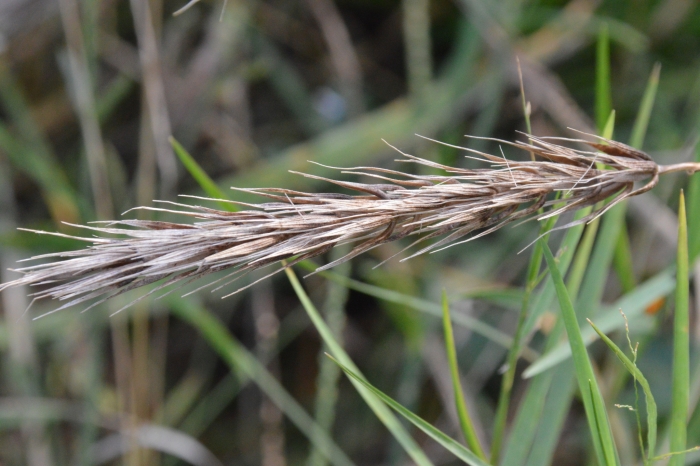Virginia Wildrye
(Elymus virginicus)
Virginia Wildrye (Elymus virginicus)
/
/

Dan Johnson
CC BY 4.0
Image By:
Dan Johnson
Recorded By:
Copyright:
CC BY 4.0
Copyright Notice:
Photo by: Dan Johnson | License Type: CC BY 4.0 | License URL: http://creativecommons.org/licenses/by/4.0/ | Rights Holder: Dan Johnson | Publisher: iNaturalist | Date Created: 2020-10-14T09:17:21-07:00 |




















































Estimated Native Range
Summary
Elymus virginicus, commonly known as Virginia Wildrye, is a perennial grass that exhibits both evergreen and semi-deciduous characteristics, depending on the climate. It is native to a variety of habitats including open woodlands, forest edges, and riparian areas across most of the United States and parts of Canada. Virginia Wildrye typically grows to a height of 3 feet (0.9 meters) and a width of 1-2 feet (0.3-0.6 meters), featuring a clumping form with slender stems and nodding seed heads that are particularly attractive during the late summer and fall.
Virginia Wildrye is valued for its adaptability and is often used for soil stabilization, restoration projects, and as a component in meadow and prairie plantings. Its ability to thrive in both sun and partial shade, along with its tolerance for a range of soil moisture conditions, makes it a versatile choice for gardeners. It is also appreciated for its wildlife value, as it provides food and habitat for birds and other animals. While it is palatable to livestock, it requires proper grazing management to prevent decline. Virginia Wildrye should be cut early for hay to prevent ergot, a fungal disease that can contaminate the seed heads. Despite its preference for heavy, fertile soils, it is highly adaptable and can grow in less ideal conditions, including shaded areas.CC BY-SA 4.0
Virginia Wildrye is valued for its adaptability and is often used for soil stabilization, restoration projects, and as a component in meadow and prairie plantings. Its ability to thrive in both sun and partial shade, along with its tolerance for a range of soil moisture conditions, makes it a versatile choice for gardeners. It is also appreciated for its wildlife value, as it provides food and habitat for birds and other animals. While it is palatable to livestock, it requires proper grazing management to prevent decline. Virginia Wildrye should be cut early for hay to prevent ergot, a fungal disease that can contaminate the seed heads. Despite its preference for heavy, fertile soils, it is highly adaptable and can grow in less ideal conditions, including shaded areas.CC BY-SA 4.0
Plant Description
- Plant Type: Grass
- Height: 2-4 feet
- Width: 1-2 feet
- Growth Rate: Moderate
- Flower Color: N/A
- Flowering Season: Spring, Summer
- Leaf Retention: Deciduous
Growth Requirements
- Sun: Full Sun, Part Shade
- Water: Medium
- Drainage: Fast, Medium, Slow
Common Uses
Bank Stabilization, Bird Garden, Butterfly Garden, Deer Resistant, Erosion Control, Low Maintenance, Street Planting, Water Garden
Natural Habitat
Native to open woodlands, forest edges, and riparian areas across most of the United States and parts of Canada
Other Names
Common Names: Virginia Wild Rye, Common Eastern Wildrye, Terrell Grass, Élyme De Virginie
Scientific Names: , Elymus virginicus, Elymus glabriflorus, Elymus virginicus var. glabriflorus, Elymus virginicus var. intermedius, Elymus virginicus f. jejunus, Elymus glabriflorus var. australis, Elymus virginicus var. halophilus, Elymus virginicus var. jejunus, Elymus striatus
GBIF Accepted Name: Elymus virginicus L.